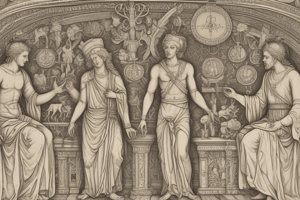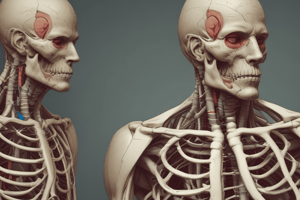Podcast
Questions and Answers
What change contributed significantly to the advancement of anatomical knowledge during the Renaissance?
What change contributed significantly to the advancement of anatomical knowledge during the Renaissance?
- Strict adherence to Galen's teachings
- Increased support from the Church
- Reduction in the power of the Church (correct)
- Elimination of public dissections
Which of the following was a significant contribution of Andreas Vesalius to anatomy during the Renaissance?
Which of the following was a significant contribution of Andreas Vesalius to anatomy during the Renaissance?
- He performed surgery to correct heart issues
- He invented the printing press
- He emphasized the importance of hands-on dissection (correct)
- He relied solely on Galen's texts for his studies
What did William Harvey prove about the heart during the Renaissance?
What did William Harvey prove about the heart during the Renaissance?
- The heart aids in digestion
- The heart functions as a central organ for energy
- The heart is a pump that circulates blood (correct)
- The heart does not pump blood
What was one of Vesalius's findings that challenged Galen's work?
What was one of Vesalius's findings that challenged Galen's work?
What technique did Harvey use to support his claims about blood circulation?
What technique did Harvey use to support his claims about blood circulation?
Which of the following best describes the impact of the printing press on Renaissance anatomy knowledge?
Which of the following best describes the impact of the printing press on Renaissance anatomy knowledge?
Which of the following surgeries remained common during the Renaissance?
Which of the following surgeries remained common during the Renaissance?
What was a primary focus of scientific study during the Renaissance that influenced anatomy?
What was a primary focus of scientific study during the Renaissance that influenced anatomy?
What method did Ambroise Paré introduce for treating gunshot wounds instead of boiling oil?
What method did Ambroise Paré introduce for treating gunshot wounds instead of boiling oil?
What was a major drawback of the ligatures used by Paré after amputations?
What was a major drawback of the ligatures used by Paré after amputations?
What traditional belief continued to influence doctors during the Renaissance despite new discoveries?
What traditional belief continued to influence doctors during the Renaissance despite new discoveries?
What innovative treatment did Paracelsus advocate instead of the traditional approaches?
What innovative treatment did Paracelsus advocate instead of the traditional approaches?
What was the main risk associated with the inoculation method used for smallpox?
What was the main risk associated with the inoculation method used for smallpox?
What discovery did Edward Jenner make regarding cowpox and smallpox?
What discovery did Edward Jenner make regarding cowpox and smallpox?
What was one reason people opposed Jenner's vaccination method?
What was one reason people opposed Jenner's vaccination method?
What significant support did Jenner receive to help promote his vaccination method?
What significant support did Jenner receive to help promote his vaccination method?
Why did many patients die from the traditional inoculation method?
Why did many patients die from the traditional inoculation method?
In what way did the Great Plague of 1665 influence local practices?
In what way did the Great Plague of 1665 influence local practices?
What was the general perception of herbal remedies during the Renaissance?
What was the general perception of herbal remedies during the Renaissance?
What key factor prevented some doctors from accepting Jenner's vaccination process?
What key factor prevented some doctors from accepting Jenner's vaccination process?
How did Jenner conclude that cowpox could provide immunity against smallpox?
How did Jenner conclude that cowpox could provide immunity against smallpox?
What best describes the impact of traditional methods like blood-letting during the Renaissance?
What best describes the impact of traditional methods like blood-letting during the Renaissance?
Flashcards
Renaissance Anatomy Advancements
Renaissance Anatomy Advancements
Advances in understanding the human body during the Renaissance, driven by factors like decreased Church influence, scientific study, new artistic techniques, and the printing press.
Vesalius's Contributions
Vesalius's Contributions
Vesalius challenged Galen's ideas by dissecting human bodies, performing public dissections, and corrected anatomical errors, writing "On the Fabric of the Human Body" with accurate illustrations.
Galen's Mistakes
Galen's Mistakes
Galen, a prominent physician, had anatomical inaccuracies about the jawbone, the heart septum, and human anatomy in general. Vesalius proved him wrong.
William Harvey's Discoveries
William Harvey's Discoveries
Signup and view all the flashcards
Renaissance Surgery
Renaissance Surgery
Signup and view all the flashcards
Impact of the Printing Press
Impact of the Printing Press
Signup and view all the flashcards
Scientific Study in the Renaissance
Scientific Study in the Renaissance
Signup and view all the flashcards
Impact of Decreased Church Power
Impact of Decreased Church Power
Signup and view all the flashcards
Ambroise Paré
Ambroise Paré
Signup and view all the flashcards
Gunshot wound treatment
Gunshot wound treatment
Signup and view all the flashcards
Ligatures
Ligatures
Signup and view all the flashcards
Theory of the Four Humours
Theory of the Four Humours
Signup and view all the flashcards
Herbal remedies
Herbal remedies
Signup and view all the flashcards
Paracelsus
Paracelsus
Signup and view all the flashcards
Great Plague of 1665
Great Plague of 1665
Signup and view all the flashcards
Inoculation
Inoculation
Signup and view all the flashcards
Edward Jenner
Edward Jenner
Signup and view all the flashcards
Vaccination
Vaccination
Signup and view all the flashcards
Smallpox eradication
Smallpox eradication
Signup and view all the flashcards
Cowpox
Cowpox
Signup and view all the flashcards
William Harvey
William Harvey
Signup and view all the flashcards
Study Notes
Renaissance Anatomy Advances
- Renaissance advancements in anatomy stemmed from several factors:
- Reduced Church influence, allowing more frequent dissections at universities. This spurred challenges to Galen's work.
- Increased interest in observation and experimentation, instead of solely relying on ancient texts.
- Development of more accurate artistic techniques for depicting the human body, facilitating knowledge sharing.
- The printing press enabled faster and wider distribution of anatomical knowledge.
Vesalius' Contributions
- Vesalius, a Padua University anatomy professor (1537), challenged Galen's work by studying human bodies directly.
- He famously allegedly stole the body of an executed criminal for study.
- He conducted public dissections.
- He corrected several Galenic errors, including identifying the human jaw as a single bone opposed to two.
- He also demonstrated the septum in the heart has no holes, contradicting Galen.
- He wrote On the Fabric of the Human Body, illustrating accurate anatomical depictions, widely circulated across Europe.
Harvey's Contributions
- William Harvey, in line with Renaissance scientific inquiry, challenged Galen's theories on the heart and blood circulation.
- He used careful experimentation, observation, and measurement to prove the heart's function as a pump and blood circulation.
- Dissections on live lizards were conducted.
- Experiments involved forcing rods and liquids through arteries to demonstrate one-way blood flow.
- Harvey published his findings but faced opposition from other doctors resistant to Galenic reassessment.
Renaissance Surgery
- Renaissance surgery remained mostly unchanged from medieval practices, primarily focusing on three procedures: trephining, amputation, and tumor removal.
- Ambroise Paré, a Renaissance surgeon, made important improvements in treating gunshot wounds.
- He replaced painful boiling oil treatment with an ointment made from turpentine, proving effective and significantly less painful.
- He introduced ligatures for tying arteries after amputation instead of burning the stump, which eased pain.
- The lack of sterilization with ligatures, however, led to frequent infections, hindering the wider adoption of his technique.
Limitations of Renaissance Anatomical Discoveries
- Despite Vesalius' and Harvey's groundbreaking work on anatomy, their findings were not widely implemented in treatment or surgery.
- William Harvey continued to use bloodletting even understanding blood quantity remained unchanged.
- Paré's advancements in gunshot wound treatment only affected a limited number of individuals involved in battles.
Traditional and Emerging Methods in Treatment (1600s-1700s)
- Traditional methods, rooted in the Four Humours theory, persisted.
- Doctors continued to employ practices like bloodletting and purging.
- Herbal remedies remained ubiquitous in medicine.
- Supernatural explanations (e.g., divine punishment, planetary influence) persisted, notably during the Great Plague of 1665.
- New approaches emerged, including those used during the Great Plague:
- Quarantine and late-night burials.
- Paracelsus' rejection of the Four Humours theory in favor of metal and mineral-based remedies. Discovery of new medicinal plants/herbs.
- Some doctors proposed the idea of airborne diseases.
Inoculation
- Inoculation, a traditional method to prevent smallpox, involved introducing pus from smallpox scabs into a patient's skin.
- It presented a risk of death or transmitting the disease further, with only the very wealthy able to afford it.
Edward Jenner and Vaccination
- Edward Jenner, a Gloucestershire doctor, observed milkmaids' resistance to smallpox after recovering from cowpox.
- Subsequent experimentation, with positive outcomes in testing, demonstrated cowpox inoculation prevented smallpox (called vaccination by Jenner).
- Jenner's discovery encountered strong opposition.
- Concerns arose regarding new ideas, and how to explain them.
- Doctors' financial interests in inoculation methods were threatened.
- Vaccination's inherent risks.
Vaccination's Adoption
- Government support, like funding for a London clinic, secured improved widespread adoption of Jenner's vaccination method.
- Britain mandated vaccinations to help eradicate smallpox.
- Smallpox eradication achieved in the 1900s through mass vaccination programmes.
Studying That Suits You
Use AI to generate personalized quizzes and flashcards to suit your learning preferences.



